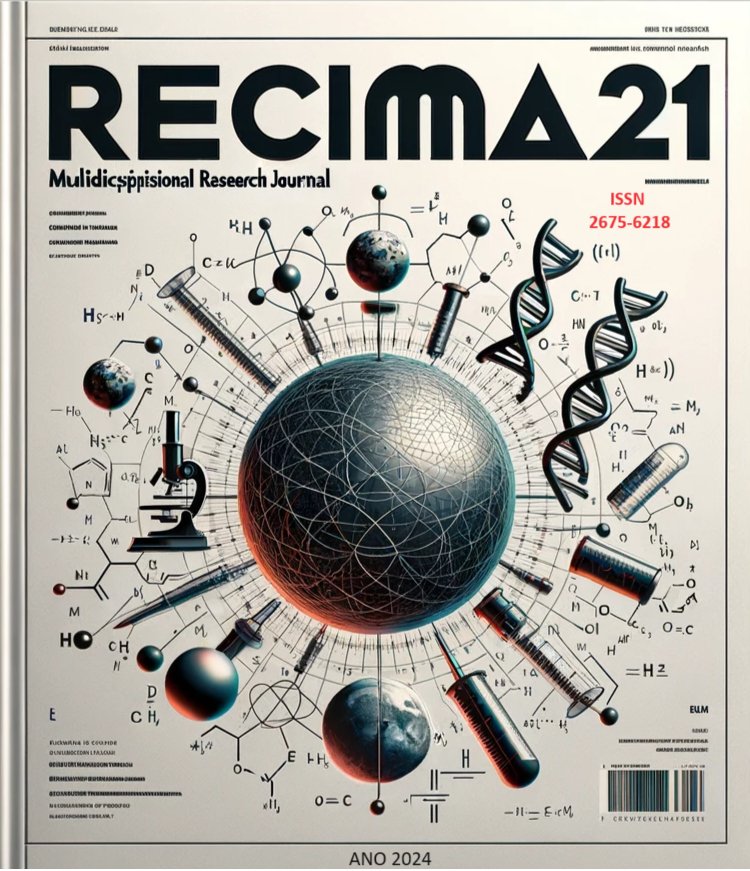METABÓLITOS BIOATIVOS PRESENTES EM GARRAFADA INDICADA PARA TRATAMENTO DA INFERTILIDADE FEMININA, PREPARADA DE ACORDO COM RECEITA DA INTERNET
DOI:
https://doi.org/10.47820/recima21.v5i4.5150Palavras-chave:
Garrafadas, infertilidade feminina, tratamentos popularesResumo
Dentre as preparações realizadas com plantas medicinais, a “garrafada” é uma das mais difundidas popularmente, podendo ser adquirida no comércio popular ou preparada de forma caseira. Embora o uso de garrafadas seja uma prática comum no Brasil, na legislação não há referência a tais produtos. Nesta pesquisa foi avaliada a receita de uma garrafada indicada para tratar a infertilidade feminina, composta por romã (Punica granatum L.), unha de gato (Uncaria tomentosa), uxi amarelo (Endopleura uchi), cravo da índia (Syzygium aromaticum) e inhame (Colocasia esculenta (L.) Schott). Inicialmente, se realizou uma pesquisa bibliográfica para verificar se nestas espécies há metabólitos com atividades farmacológicas comprovadas, relacionadas ao tratamento da infertilidade. Em seguida, foram preparados, por maceração, os extratos de cada uma das espécies vegetais e de todas as espécies juntas, em metanol e em vinho, para verificar a presença dos marcadores químicos e comparar a eficiência das extrações. A determinação da composição química dos sistemas foi realizada por meio da análise dos espectros obtidos por ESI-MS. Os resultados mostraram que as espécies vegetais apresentam metabólitos com ação farmacológica relacionada ao tratamento da infertilidade. Os extratos em metanol apresentaram maior número de metabólitos do que os extratos preparados em vinho, corroborando a tese de que o sistema extrator utilizado em garrafadas não é o mais eficiente. Os fitofármacos encontrados na garrafada, que apresentam ações farmacológicas relacionadas ao tratamento da infertilidade foram a isocumarina bergenina, o ácido gálico e a apeginina.
Downloads
Referências
ANIBAL, P. C. et al. Antifungal activity of the ethanolic extracts of Punica granatum L. and evaluation of the morphological and structural modifications of its compounds upon the cells of Candida ssp. Brazilian Journal of Microbiology, v. 44, n. 3, p. 839-848, 2013. DOI: https://doi.org/10.1590/S1517-83822013005000060
ANVISA - AGÊNCIA NACIONAL DE VIGILÂNCIA SANITÁRIA. Farmacopéia Brasileira. 6 ed. Brasilai; Anvisa, 2019. vol. 2.
ANWAR, M. et al. Water-soluble non-starch polysaccharides of root and tuber crops: extraction, characteristics, properties, bioactivities, and applications. Critical Reviews in Food Science and Nutrition, v. 62, n. 9, p. 2309-2341, 2022. DOI: https://doi.org/10.1080/10408398.2020.1852388
BATIHA, G. E. S. et al. Uncaria tomentosa (Willd. ex Schult.) DC.: A Review on Chemical Constituents and Biological Activities. Applied sciences, v. 10, n. 8, p. 2668, 2020. DOI: https://doi.org/10.3390/app10082668
CHAGAS, R. B. et al. Planejamento familiar em aspectos reprodutivos para casais com infertilidade. Revista Ibero-Americana de Humanidades, Ciências e Educação, v. 6, n. 11, p. 231-249, 2020. DOI: https://doi.org/10.51891/rease.v6i11.4895
FÉLIS, K. C.; ALMEIDA, R. J. Perspectiva de casais em relação à infertilidade e reprodução assistida: uma revisão sistemática. Reprodução & Climatério, v. 31, n. 2, p.105-111, 2016. DOI: https://doi.org/10.1016/j.recli.2016.01.004
FELIX, F. J. et al. Utilização de plantas medicinais na elaboração de garrafadas para fins terapêuticos no semiárido brasileiro. Research, Society and Development, v. 11, n. 16, e535111634508, 2022. DOI: https://doi.org/10.33448/rsd-v11i16.34508
GADELHA, C. S. et al. Estudo bibliográfico sobre o uso das plantas medicinais e fitoterápicos no Brasil. Revista Verde de Agroecologia e Desenvolvimento Sustentável, v. 8, n. 5, p. 208-212, 2013.
GLAZER, I. et al. Partial identification of antifungal compounds from Punica granatum pell extracts. Journal of Agricultural and Food Chemistry, v. 60, p. 4841-8, 2012. DOI: https://doi.org/10.1021/jf300330y
MINISTÉRIO DA SAÚDE. Resolução da Diretoria Colegiada – RDC No 26. Brasília: Agência Nacional de Vigilância Sanitária, 2014.
PANDEY, V. K. et al. Bioactive properties of clove (Syzygium aromaticum) essential oil nanoemulsion: A comprehensive review. Heliyon, v. 10, n. 1, p. e22437-e22437, 2024. DOI: https://doi.org/10.1016/j.heliyon.2023.e22437
PASSOS, M. M. B. et al. A disseminação cultural das garrafadas no Brasil: um paralelo entre medicina popular e legislação sanitária. Saúde em Debate, v. 42, n. 116, p. 248–262, 2018. DOI: https://doi.org/10.1590/0103-1104201811620
PEREIRA, P. R. et al. Tarin, a Potential Immunomodulator and COX‐Inhibitor Lectin Found in Taro (Colocasia esculenta). Comprehensive reviews in food science and food safety, v. 17, n. 4, p. 878-891, 2018. DOI: https://doi.org/10.1111/1541-4337.12358
SILVA, R. L.; TEIXEIRA R. Phenolic profile and biological potential of Endopleura uchi extracts. Asian Pacifica Journal of Tropical Medicine, v. 8, n. 11, p.889-897, 2015. DOI: https://doi.org/10.1016/j.apjtm.2015.10.013
SILVA, S. L. et al. Antimicrobial activity of bergenin from Endopleura uchi (Huber) Cuatrec. Acta Amazonica, v. 39, n. 1, p. 187-191, 2009. DOI: https://doi.org/10.1590/S0044-59672009000100019
Downloads
Publicado
Licença
Copyright (c) 2024 RECIMA21 - Revista Científica Multidisciplinar - ISSN 2675-6218

Este trabalho está licenciado sob uma licença Creative Commons Attribution 4.0 International License.
Os direitos autorais dos artigos/resenhas/TCCs publicados pertecem à revista RECIMA21, e seguem o padrão Creative Commons (CC BY 4.0), permitindo a cópia ou reprodução, desde que cite a fonte e respeite os direitos dos autores e contenham menção aos mesmos nos créditos. Toda e qualquer obra publicada na revista, seu conteúdo é de responsabilidade dos autores, cabendo a RECIMA21 apenas ser o veículo de divulgação, seguindo os padrões nacionais e internacionais de publicação.













